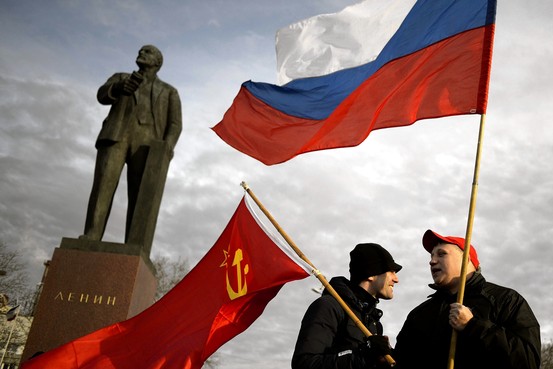Turmoil in Ukraine

Pro-Russian protestors in Simferpol, Ukraine.
March 17, 2014
Over the last five months, Ukrainian president Viktor Yanukovych’s controversial decisions have led the country into chaos. Peaceful protests have turned to violent riots, the bureaucracy has fallen apart, and now Russian forces have been mobilized by President Vladimir Putin on the border of Ukraine’s Crimean Peninsula.
The mayhem in Ukraine began on Nov. 21 when President Yanukovych abandoned an agreement that would strengthen the nation’s relationship with the European Union (EU). The decision would move Ukraine towards a pact favoring Russia and its customs union – rather than the EU’s union – which upset most Ukrainian citizens because their country is in debt to Russia (the main supplier of gas for Ukraine and many EU member states). Putin has urged Ukraine to join the Russian customs union to maximize his country’s profits and continue their dominance in the production and deliverance of gas.
Protests grew to 100,000 people in Ukraine’s capital, Kiev; police deployed tear gas and arrested 35 demonstrators. BBC News reported after the protest that “Russian President Vladimir Putin accused the EU of blackmailing Ukraine to sign the deal.” On Dec. 1, 800,000 protestors gathered in Kiev’s Independence Square (known locally as Maidan) and occupied city hall.
The situation worsened on Jan. 16 when Ukraine’s Parliament passed multiple anti-protest laws. Two people – the first victims of the crisis – died from gunshot wounds and a third was killed in an altercation with the police. Prime Minister Mykola Azarov resigns and the anti-protest laws are repealed on Jan. 28. All 234 protesters imprisoned since the Kiev city hall was occupied were released by mid-February.
This short-term peace ended between February 18 and 20 when the most violent riots of the crisis broke out. At least 88 were killed in only 48 hours. The following day, President Yanukovych signed an agreement calling for elections as early as December 2014; this would be the president’s final actions as the next day he disappeared from his office in Kiev to an undisclosed location in Russia. Olexander Turchynov and Arseniy Yatsenyuk were named the interim president and prime minister, respectively. Yanukovych still claims he is the rightful president.
Now, the attention has shifted to the Crimean Peninsula, Ukraine’s primary outlet to the Black Sea. Crimea was conquered by Russian empress Catherine the Great in the 18th century, but was relinquished to Ukraine in 1954 under Soviet leader, Nikita Khrushchev. The peninsula is comprised primarily of ethnic Russians.
Since the end of February, Putin has mobilized Russian troops to once again take control of the critical Black Sea territory. Tension grew as the world waited for a Ukrainian response. Surprisingly, Crimea’s Parliament announced a public vote would take place on March 16 to determine its fate. The vote took place despite Ukraine, the US, and major European countries warning Russia and Crimea to step down; thus, the crisis could not be controlled by foreign powers. Nearly 1.2 million Crimean citizens voted to secede from Ukraine and join Russia. This result received approximately 96% of the vote.
As the turmoil progresses in Ukraine, the only factor we are certain of is the crisis is unpredictable.


